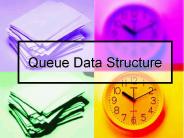CS240 - 91 Data Structures - PowerPoint PPT Presentation
1 / 16
Title:
CS240 - 91 Data Structures
Description:
Understand the fundamental ways of organizing collections ... multimap. stack. queue. string. bitset. istream. ostream. iostream. ifstream. ofstream. fstream ... – PowerPoint PPT presentation
Number of Views:65
Avg rating:3.0/5.0
Title: CS240 - 91 Data Structures
1
CS240 - 91 Data Structures
- Spring 2006
2
Some Course Goals
- Understand the fundamental ways of organizing
collections of data to be processed by a program - focus is on main-memory data structures
- Be able to evaluate the efficiency of data
structures and their algorithms - memory space needed to store the data
- efficiency of algorithms to manipulate the data
- Be able to define, implement and use Abstract
Data Types (ADTs) - Learn to use libraries of data structures
provided by HLLs (STL, Java Collection classes)
3
Prerequisites
- CS-140 Intro to Computer Programming
- given a problem specification design, code,
test, and document a program which meets that
specification - Programming language constructs
- primitive data types, arithmetic and relational
operators, arrays, conditional and iterative
structures, functions (methods), arguments and
parameters and return values, I/O
4
Language Used in CS240
- This is a course in Data Structures!
- principles are language independent
- We will be using C
- Platforms
- Lab Linux or Cygwin
- Home Linux, Knoppix, Cygwin
- programs submitted must compile using the GNU
compiler
5
ANSI C Compilers
- GNU compiler
- open source software from the Free Software
Foundation - www.gnu.org
- available on Bingsuns
- built-in on most Linux systems
- Cygwin is a Unix-like environment (including the
GNU compiler) for Windows (sources.redhat.com/cygw
in/) - Microsoft Visual C
- integrated editor, compiler, linker, project
manager (IDE) - version 6.0 is on all Computer Center PCs and in
Watson Microlab - free to students in Watson courses through the
Microsoft Academic Alliance - www.cplusplus.com/info/compilers/
6
Course Material
- Syllabus and other course information available
at - dforeman.cs.binghamton.edu/foreman
- Makefiles. See
- www.gnu.org/manual/make-3.80/make.html
7
Data Algorithms Programs
- Every program processes some data
- Data has to be stored in memory at run-time
- Java, C, C are strongly typed languages
- all data items have a type associated with them
- Data to be processed is stored by declaring data
objects (variables) - type name
- type name value
- Type of a data object determines
- what can be done (operations)
- how the data is represented in memory
8
Types
- Pre-defined (built-in) types
- scalar (atomic) types store a single value
- structured types store a collection of values
- Most languages have libraries of types
- STL of C
- Java library
- Programmer-defined types
- create new types appropriate for the problem
being solved - built from pre-defined types
9
Java's Data Types
- Primitive types
- byte, short, int, long, float, double, char,
boolean - are built-in and scalar
- variable name is directly associated with the
memory location of the value - Class types
- value is a reference to (memory address of) an
object - the object is instantiated using new
- variable name is indirectly associated with the
memory location of an object
10
C Types
Structured Types
Scalar Types
array struct union class
Arithmetic
void
pointer
bool
complex
Integral
Floating point
(reals)
float double long double
Characters
Integers
Enumerations
int short int long int unsigned short
unsigned long unsigned
char unsigned char signed char
11
Abstract Data Type
- Consists of
- a collection of data items
- operations that can be performed on the
collection - Is independent of programming language
- Has
- Definition of data and operations (what)
- Implementation how data is stored and
algorithms to carry out the operations - User uses the ADT to solve a problem doesn't
need to know the implementation details
12
Built-in Types as ADTs
- Definition of the ADT integer
- Data items
- an integer value in the set ,-3, -2, -1, 0, 1,
2, 3, - Maximum and minimum values are determined by the
storage representation used - Operations
- Binary arithmetic operations , -, , /,
- Unary arithmetic operations , -
- Relational operations , !, lt, lt, gt, gt
13
Implementation
- How is an integer value stored?
- Number of bytes of memory?
- How is the value represented as a sequence of
bits? - sign-magnitude
- 2's complement
- biased notation
- Algorithms to carry out the operations
- Depend on choice of representation
- Make use of machine architecture
14
Use
- Principle of data abstraction definition of a
data type separate from implementation. - User of an ADT does not need to know the
implementation of the ADT. - User needs to know the syntax and behavior of the
ADT's operations. - Implementation of an ADT does affect the
efficiency of an ADT's operations.
15
Help with C
- www.cplusplus.com/doc/tutorial/
- sections 1 and 2
16
Some Comparisons
- Java syntax comes from C (and C)
- control structures (if, if-else, do while, for,
switch, ..) - primitive types (int, float, double, char, ..)
- Java (almost) pure OO
- C a hybrid of OO and procedural
- has "free" functions (independent of a class)
- Java is compiled to byte code which is executed
by a Java interpreter (JVM) - C is compiled to object code from which a
machine executable file is created






























![Data Structures [1] PowerPoint PPT Presentation](https://s3.amazonaws.com/images.powershow.com/7170786.th0.jpg?_=20150917062)
